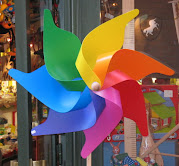More reposting from the Women in ministries blog follows. I will write something more personal reflections over coming days. Hope this is interesting nevertheless. On Wednesday morning we continued to remember the Bible stories we had done our scrapbooking about and in groups of two told each other the remembered story of the picture that our artistic works focused on. More of that a bit later on in another post I think.
On Wednesday morning we continued to remember the Bible stories we had done our scrapbooking about and in groups of two told each other the remembered story of the picture that our artistic works focused on. More of that a bit later on in another post I think.
As part of encopuraging us to begin to make the connections between the biblical, individual and communal narratives we are all part of and which are part of us, Janet Lees encouraged us to read Tom Thatcher's Jesus The Riddler which has some interesting ideas apparently about the parables as extended riddles in the oral culture that marked Jesus preaching and story-telling styles.
She also mentioned Mary Ann Beavis' book The Lost Coin which I've used with my feminist theology group (I'd particularly recommend the chapter on the wise and foolish virgins). The point being that paraboling, riddling perhaps too - and who knows maybe even scrapbooking and remembering - are to some extent ways of resolving the pain, ambiguity and darkness in life and understanding. The other point being that it is important to use more than one person's method in the understanding of the world of the Bible. Janet admitted to us that much as she had felt able to take up William Herzog's idea straight away she had found Thatcher's riddling idea rather more difficult to get to grips with in the first instance. Anyway we mention all of this for others to be able to add their ideas and comments - and in the hope that you will leave us some links too.
We'll do a post later about chaos and ambiguity following on form our powerful morning prayer reflection by Kate Gray but in the meantime here's some of the blurb about Jesus the Riddler:
As most readers of the New Testament know, the words of Jesus are often spoken in riddles?in parables and other sayings that were and continue to be difficult to understand. Tom Thatcher explains in his latest book that Jesus may have been intentionally ambiguous, using riddles to establish his authority as a teacher and to encourage his followers to think more deeply about the nature of truth. Jesus? riddles, like riddles across many cultures, potentially refer to many different things, and they challenge those who hear them to decode the meaning the riddler intends. Figuring out the riddles in which Jesus spoke requires a depth of faith and close attention to the words of the gospel. With text boxes and helps to the reader, this book guides readers through discerning these puzzling and important words
Wednesday 14 January 2009
Jesus the Riddler helping us make connections between the different narratives
Subscribe to:
Post Comments (Atom)





0 Comments:
Post a Comment